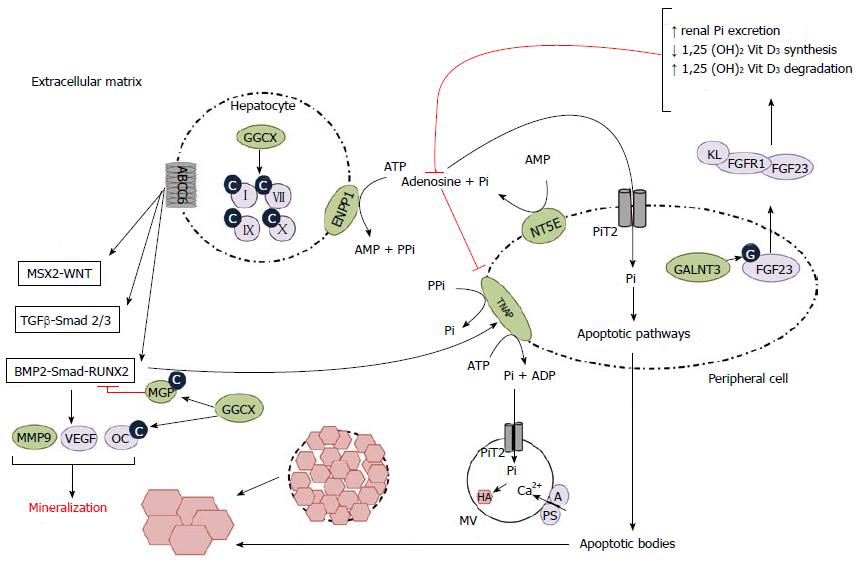Copyright
©The Author(s) 2015.
World J Clin Cases. Jul 16, 2015; 3(7): 556-574
Published online Jul 16, 2015. doi: 10.12998/wjcc.v3.i7.556
Published online Jul 16, 2015. doi: 10.12998/wjcc.v3.i7.556
Figure 1 Schematic representation of the pathophysiological mechanisms leading to ectopic mineralization.
Hepatocyte: Impairment of ABCC6 function leads to upregulation of pro-osteogenic pathways (MSX2-WNT, TGFβ-Smad 2/3, BMP2-Smad-RUNX2), upregulation of their downstream targets and eventually to ectopic mineralization. GGCX carboxylates and hence activates multiple targets, such as coagulation factors and MGP, the latter being a potent BMP2-inhibitor and hence mineralization inhibitor. When GGCX function is impaired, these targets stay inactive, leading to increased mineralization. ENPP1 converts ATP to AMP and PPi, the latter being a mineralization inhibitor. Impairment of this conversion and hence a decrease in the PPi level leads to increase in ectopic mineralization. Peripheral cell: After glycosylation by GALNT3, FGF23 forms a complex with FGFR1 and KL (coreceptor) which leads to increased renal excretion of Pi, a pro-mineralizing agent and decreased 1,25 dihydroxyvitamin D3, causing a decrease in intestinal Pi absorption. NT5E converts AMP to Pi and adenosine, which inhibits the pro-mineralizing TNAP. Impairment of NT5E function leads to increased TNAP activity and decreased PPi concentration, hence leading to ectopic mineralization. Pi is internalized into the peripheral cell by PiT2 and leaves the cell through apoptotic bodies, which cause ectopic mineralization through apoptotic pathways (not shown). In MVs an influx occurs of Pi via PiT2 and of Ca2+, which is facilitated by A and PS. This leads to an accumulation of growing hydroxyapatite crystals, eventually causing the MVs to burst and the crystals to grow in the extracellular matrix. A: Annexin A5; ABCC6: Adenosine triphosphate-binding cassette, subfamily C, member 6; ADP: Adenosine diphosphate; AMP: Adenosine monophosphate; ATP: Adenosine triphosphate; BMP2: Bone morphogenetic protein 2; C: Carboxyl; Ca2+: Calcium 2+; ENPP1: Ectonucleotide pyrophosphatase/phosphodiesterase 1; FGF23: Fibroblast growth factor 23; FGFR1: Fibroblast growth factor receptor 1; G: Glycosyl-; GALNT3: UDP-N-acetyl-alpha-D-galactosamine: Polypeptide N-acetylgalactosaminyltransferase 3; GGCX: Gamma-glutamyl carboxylase; HA: Hydroxyapatite; KL: Klotho; MGP: Matrix gla protein; MMP9: Matrix metalloproteinase; MSX2: Muscle segment homeobox, drosophila, homolog of, 2; MV: Matrix vesicle; NT5E: Ecto-5-prime nucleotidase or CD73; OC: Osteocalcine; Pi: Inorganic phosphate; SLC20A2: Solute carrier family 20 (phosphate transporter), member 2; PPi: Inorganic pyrophosphate; PS: Phosphatidyl serine; RUNX2: Runt-related transcription factor; Smad: Mothers against decapentaplegic, drosophila, homolog of; TGFβ: Transforming growth factor β; TNAP: Tissue-non-specific alkaline phosphatase; VEGF: Vascular endothelial growth factor; WNT: Wingless-type MMTV integration site family; II, VII, IX, X: Vitamin K-dependent coagulation factors; 1,25 (OH)2 Vit D3: 1,25-dihydroxyvitamine D3 (calcitriol).
- Citation: Vilder EYD, Vanakker OM. From variome to phenome: Pathogenesis, diagnosis and management of ectopic mineralization disorders. World J Clin Cases 2015; 3(7): 556-574
- URL: https://www.wjgnet.com/2307-8960/full/v3/i7/556.htm
- DOI: https://dx.doi.org/10.12998/wjcc.v3.i7.556









